|
|

|
|
Author
|
Topic: Space Cover 397: Christmas in space
|
cvrlvr99
Member Posts: 209
From: Arlington, TX
Registered: Aug 2014
|
 posted 12-24-2016 01:42 PM
posted 12-24-2016 01:42 PM
   
Space Cover of the Week, Week 397 (December 25, 2016)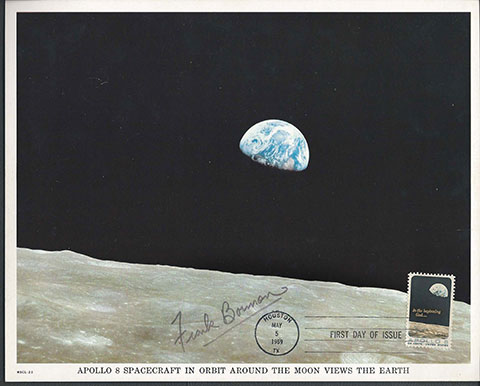 Space Cover #397: Christmas in Space We are now approaching lunar sunrise, and for all the people back on Earth, the crew of Apollo 8 has a message that we would like to send to you. In the beginning God created the heaven and the earth, and the earth was without form and void; and darkness was upon the face of the deep. And the Spirit of God moved upon the face of the waters. And God said, Let there be light: and there was light. And God saw the light, that it was good; and God divided the light from the darkness. With those words, astronaut Bill Anders introduced the world to the view of the lunar surface from the Apollo 8 capsule as he, Jim Lovell, and Frank Borman became the first humans to orbit the moon. In turn, Jim Lovell and Frank Borman continued reading the rest of the passage through verse 10 from the Book of Genesis. Borman added, "And from the crew of Apollo 8, we close with good night, good luck, a Merry Christmas — and God bless all of you, all of you on the good Earth."For those of us sitting in our living rooms, watching the moon practically whiz by the window of the capsule, it was a very emotional experience, especially on the eve of Christmas Day. 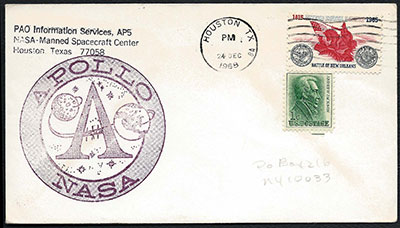 This Christmas Eve cancel was sent from the Public Affairs Office at the Manned Spacecraft Center in Houston because this site was controlling the mission. Until the new seventh version of the Manual of Philatelic Judging, this would be the only cancellation site that could be exhibited in World Series of Philately (WSP) competition. This was because the wording stated that "cancels must be from the nearest post office to the event," and neither Kennedy Space Center nor Cape Canaveral had any functions once the Saturn V cleared the launch tower on the 21st of December. 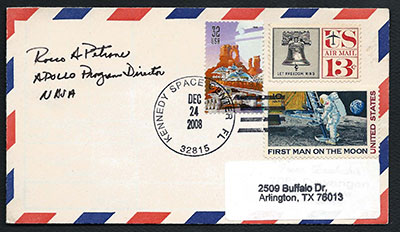 However, most collectors also had covers cancelled at the Kennedy Space Center and Cape Canaveral for this event and many were signed by members of the crews or some of the other persons involved in the Apollo 8 mission. The word "nearest" was mirrored from the FIP (Fédération Internationale de Philatélie) rules and there were many flaws with that. Flown to the moon covers bear cancels from Webster, TX (Apollo 11), Houston, (Apollo 12), Ellington AFB (Apollo 13), and the prime recovery ship, USS Okinawa (Apollo 15). I asked the FIP which cancels were valid and which were not. Apollo 7 launched from Cape Canaveral; did that mean that the Kennedy Space Center officials were not valid for that or for the Gemini 5 through Gemini 12 flights? There were other examples and the FIP agreed and changed the wording to "nearby" rather than "nearest." The NASA book, "The Kennedy Space Center Story" further relates that when Kennedy launches started, both Cape Canaveral and Patrick AFB retained several of their existing launch responsibilities. The change now validates launch covers from those two sites that were held invalid up until now. But for deep space activities, Kennedy Space Center, Cape Canaveral and Patrick AFB covers were still invalid for exhibiting. However, that NASA book also related that the Merritt Island Launch Area (MILA) is located on Kennedy Space Center property and its function was to convert the digital images from space to analog so that the viewing public could see the video streaming from lunar orbit. That means that the Kennedy Space Center post office was nearby on the same land as MILA and hence, KSC covers can then be just as valid for exhibiting as are tracking and communication stations around the globe. 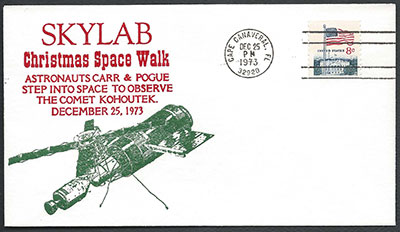 Another memorable space mission occurred on Christmas Day 1973 when the Skylab 4 crew members Jerry Carr and Bill Pogue conducted a Christmas space walk to view the comet Kohoutek while Ed Gibson, aboard the Skylab space station watched this "star" as well. It would be difficult to not tie this viewing of a "star" on Christmas day to the day when three other wise men watched a star that took them to Bethlehem. This cover bears a Christmas Day cancel from Cape Canaveral and I will still exhibit it, possibly losing a judging point for doing so, but the date and the event are too good to exclude. 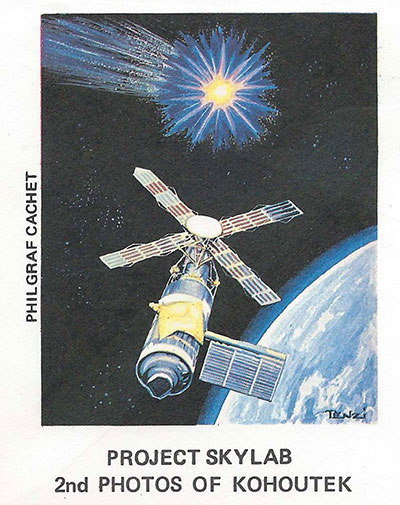 The comet was 14 million miles from the sun when the astronauts viewed it. This was the Philgraph cachet for the second space walk on December 29th and would have been ideal for the first walk. May you all have a great Christmas and may you locate some key space covers for your collections in 2017. Also, if you don't exhibit and show others evidence of our hobby, the new judging guidelines should now give you a good shot at getting better judging reviews. But it will still take several shows and judging inputs to hit Gold repeatedly as you promote Astrophilately this way. Merry Christmas! |
Ken Havekotte
Member Posts: 3788
From: Merritt Island, Florida, Brevard
Registered: Mar 2001
|
 posted 12-26-2016 08:25 AM
posted 12-26-2016 08:25 AM
   
Enjoyed your posting, Ray, about Christmas in space with Apollo 8 and Skylab IV. I can still remember myself, sitting in our Space Coast living room on Christmas Eve 1968 with my family and space worker friends, watching on TV in amazement as the first humans orbited the moon! Little did I know at the time how that epic Apollo voyage and others to follow would affect the course of my own life in the coming years.Thanks, also Ray, for the update of the WSP competition guidelines for exhibiting space covers. It was your guidance and leadership in this area, I know for a long time, that made such changes possible. But I do feel that a clarification is needed for the phrase, "and neither Kennedy Space Center and Cape Canaveral had any functions once a Saturn V cleared the tower..." On the contrary, I must say, there were indeed major connections or ties with a Saturn rocket — and for most all other missile, rocket, or space vehicle liftoffs — even after it has left the tower. During all launches from the Cape Canaveral Air Force Station and the Kennedy Space Center, a Range Safety Officer (RSO) from the Cape's Range Control Center monitors the flight from liftoff to the end of powered flight (such as an orbital insertion eight minutes or more after a liftoff). The RSO, working with his range safety team of the air force missile flight control division, is in charge with the protection of life and property in the path of a missile or space vehicle. He can destroy a launch vehicle should an erratic flight path endanger life or property. In addition, though, there are a number of radar, tracking, telemetry, ground and air support services, communications, and advanced photographic operations that take place for hundreds of miles long after the tower has been cleared. Most are located on sites all throughout the Florida Space Coast, such as CCAFS, Patrick AFB, KSC/Merritt Island, and during the Apollo/Shuttle programs — Cocoa Beach, Jupiter, and the Melbourne Beach area. Take for instance the Recording Optical Tracking Instrument (ROTI), which is a 500-inch variable focal length optical system, that is used to photograph engineering events through missile staging out to ranges of about 150 miles. A major series of radar trackers, located at Patrick and Merritt Island, contain one of the largest C-band and pulse recording radar units that can track a launch vehicle, along with other space objects, to a distance of over 60,000 nautical miles. The Tel-IV station of the NASA Spaceflight Tracking & Data Network on Merritt Island, as Ray has pointed out, converts digital images from space to analog readings, and for long after a launch vehicle has cleared it's pad umbilical structure. The station was also quite active during shuttle orbiter landings here at Kennedy, in addition to all launch phases and space flight tracking support. Not only would a KSC postmark be appropriate for any Tel-IV tracking events, but Merritt Island should qualify as well in my opinion. After all, the Tel-IV center, though on KSC grounds, is located on the geographic location of Merritt Island. But even before KSC, the early Florida space complex between the Indian and Banana Rivers had been known as the Merritt Island Launch Area (MILA). After President Kennedy's assassination in Nov. 1963, NASA changed the name of MILA to the John F. Kennedy Space Center, NASA. |
cvrlvr99
Member Posts: 209
From: Arlington, TX
Registered: Aug 2014
|
 posted 12-29-2016 08:37 PM
posted 12-29-2016 08:37 PM
   
Ken, thanks for all that additional information. Can you tell me whether or not there was any activity along the Cape Canaveral area when the Apollo 13 explosion occurred? I ask that because I have a cover from CC signed by Gene Kranz. I asked him to write the phrase, "Failure Is Not An Option" above his signature on an April 14th cover. |
Ken Havekotte
Member Posts: 3788
From: Merritt Island, Florida, Brevard
Registered: Mar 2001
|
 posted 12-30-2016 10:01 AM
posted 12-30-2016 10:01 AM
   
I'll do the best I can to answer your question, Ray, rather there were any activities along the KSC/Cape area when Apollo 13's oxygen tank exploded more than 200,000 miles from Earth.For starters, as you well know, the primary focal point was indeed at the Mission Control Center in Houston along with lots of MSC (now Johnson Space Center) support elements and participating personnel from all across the Houston space center complex. At the time of the explosion, NASA's Goddard Space Flight Center (GSFC) and the Manned Space Flight Network (MSFN) were in routine flight operational support and all throughout the entire mission. When Swigert and Lovell transmitted their first concerns, "Hey, we've got a problem here" with their spacecraft, those transmissions were made possible by GSFC and the MSFN. Those Network's tracking stations linked the joined-together spacecrafts to Earth where the signals were transmitted through Goddard. But other worldwide stations had to be called up since an emergency situation was in progress. Those stations that were instrumental with keeping track of Apollo 13's in-flight telemetry were the Goldstone tracking complex on the West Coast and the Madrid Deep Space Communications Complex in Spain, the large Parkes radio telescope facility, along with the Honeysuckle Creek station observatory and the Carnarvon tracking complex in Australia. But to answer your question, yes, KSC did in fact have a role--and in several instances--during Apollo 13's aborted lunar landing mission from April 13, when the explosion occurred, until the end of the flight on April 17, 1970. During those hectic hours/days, KSC had been called up by mission control to provide needed contractor engineers and other support personnel to monitor performance data of both spacecrafts to make sure nothing had been overlooked by other space center (mainly Houston) personnel. While on the ground at KSC, possibly needed spacecraft maneuvers were tried out and tested in Apollo flight simulators at the Flight Crew Training Building, located at the KSC Industrial Area. In fact, Dick Gordon was in a Cocoa Beach motel when first notified about the explosion, and immediately rushed over to KSC--one of the first astronauts to do so--to began the simulator workouts for testing new procedures that might be used by the crew in trying to get them home safely. The Central Instrumentation Facility (CIF) at KSC, also in the industrial area, was working with Apollo 13 as well. The CIF, which contains the many computers and data reduction systems, was receiving the telemetry from the spacecraft, along with any in-flight TV transmissions, and recording it in real time. Not only at KSC, Ray, but engineers in Downey, CA, where the CM-Odyssey was built, ran emergency problems through their computers. There was even a team of 30 at MIT that worked through those difficult days. The MIT team were the designers and builders of the Apollo guidance and navigation systems that were needed to get the Apollo 13 astronauts around the moon and back home. Several phone lines, ten as reported by NASA, were constantly kept open between Mission Control and a room staffed with 70 lunar module experts at the manufacturer's Grumman plant in Bethpage, Long Island, to address any alarming flight issues and concerns. As I'm sure you know, there were many other similar called-up groups of aerospace engineers and specialists all across the nation, some on stand-by, if needed to help with Apollo 13. In regards to your Apollo 13 flight cover on April 14 from the Cape, signed by Gene Kranz, I would have no problem with it being related to the mission, location, and signer. But I don't know, even based on the recent WSP astrophilately exhibition regulations, if they would allow a Cape cover signed by a MCC/Houston official to "qualify" for such a competition. You would know far better than anyone I know about that, Ray, but hopefully it would be permitted under the new guidelines. |
Axman
Member Posts: 395
From: Derbyshire UK
Registered: Mar 2023
|
 posted 03-03-2024 09:27 AM
posted 03-03-2024 09:27 AM
   
For a while now I've been trying to add an Apollo 8 "Christmas" moon broadcast cover to my collection... they are not as easy to find as I anticipated. Finally I managed to obtain one. It doesn't stick out from the crowd particularly, it is a nice cover and ticks a few boxes. I especially like it has a 1968 Christmas stamp, and that the TV broadcast is very prominent in the cachet design. But, I have a number of queries regarding it too. I've never come across Ikarus before - are they a well known cachet maker? And it's postmarked on the 25th December - Christmas Day itself! Do post offices open on Christmas Day in the States? |
micropooz
Member Posts: 1759
From: Washington, DC, USA
Registered: Apr 2003
|
 posted 03-03-2024 03:20 PM
posted 03-03-2024 03:20 PM
   
I can't answer your question about Ikarus - first time I've seen one of those cachets.But I can answer your question about service on Christmas Day. The US Post Office of 1968 was a very different organization than the US Postal Service (note slight change in name) of today. The Post Office back then was a purely government supported operation that focused totally on service, including servicing mail on holidays (like the above), Sundays (like July, 20, 1969), etc. The post offices may or may not have been open for walk-in service on holidays or Sundays, but mail collection and processing was still happening on those days. In 1971 the Post Office was transformed into a quasi-government Postal Service that had to pay its' own way. In the 50+ years since then, holiday/Sunday service has gone by the wayside and other services have been cut to make ends meet. |
Axman
Member Posts: 395
From: Derbyshire UK
Registered: Mar 2023
|
 posted 03-03-2024 03:32 PM
posted 03-03-2024 03:32 PM
   
Thanks Dennis. |
Ken Havekotte
Member Posts: 3788
From: Merritt Island, Florida, Brevard
Registered: Mar 2001
|
 posted 03-03-2024 04:15 PM
posted 03-03-2024 04:15 PM
   
That's correct Dennis as mail all throughout the 1960's onward at Cape Canaveral, in most all cases, could be dropped off or mailed in to CCPO for cancel dates. Philatelic mail was accepted and processed if covers were received on or before desired cancel day, but not so much afterwards. | |
Contact Us | The Source for Space History & Artifacts
Copyright 1999-2024 collectSPACE. All rights reserved.

Ultimate Bulletin Board 5.47a
|
|

|
 advertisement advertisement

|

















